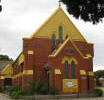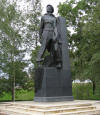Australia 2010 - Week 4+ (Wednesday 2/3 - Wednesday 2/10/2010)
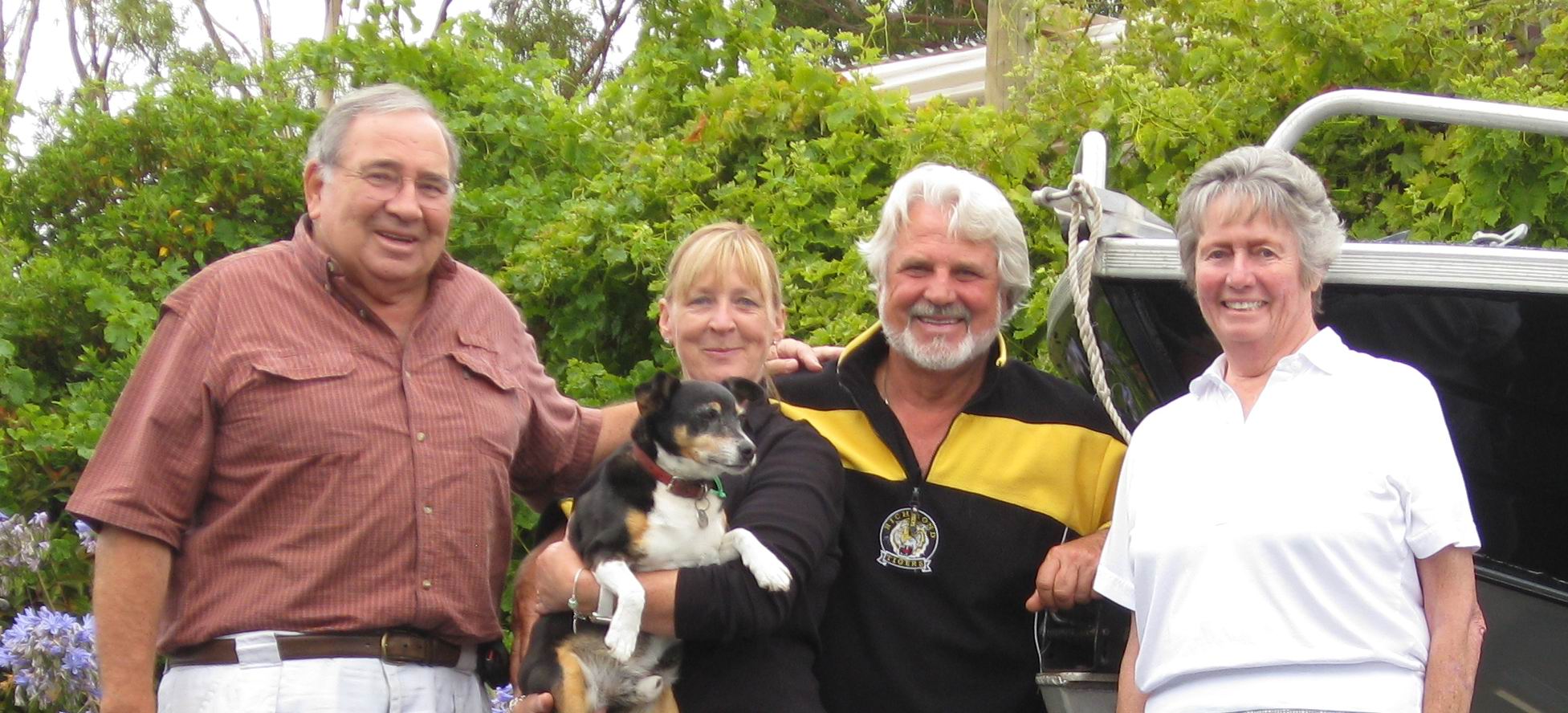
Well, as indicated, we head out of Binalong Bay on Wednesday morning, and before we leave, Des & Vi model their new sign (they are opening a B&B, and while I can't promise chow or prices like we received, I'd sure recommend the setting, and the folks, to anyone who plan to visit this gorgeous spot!).
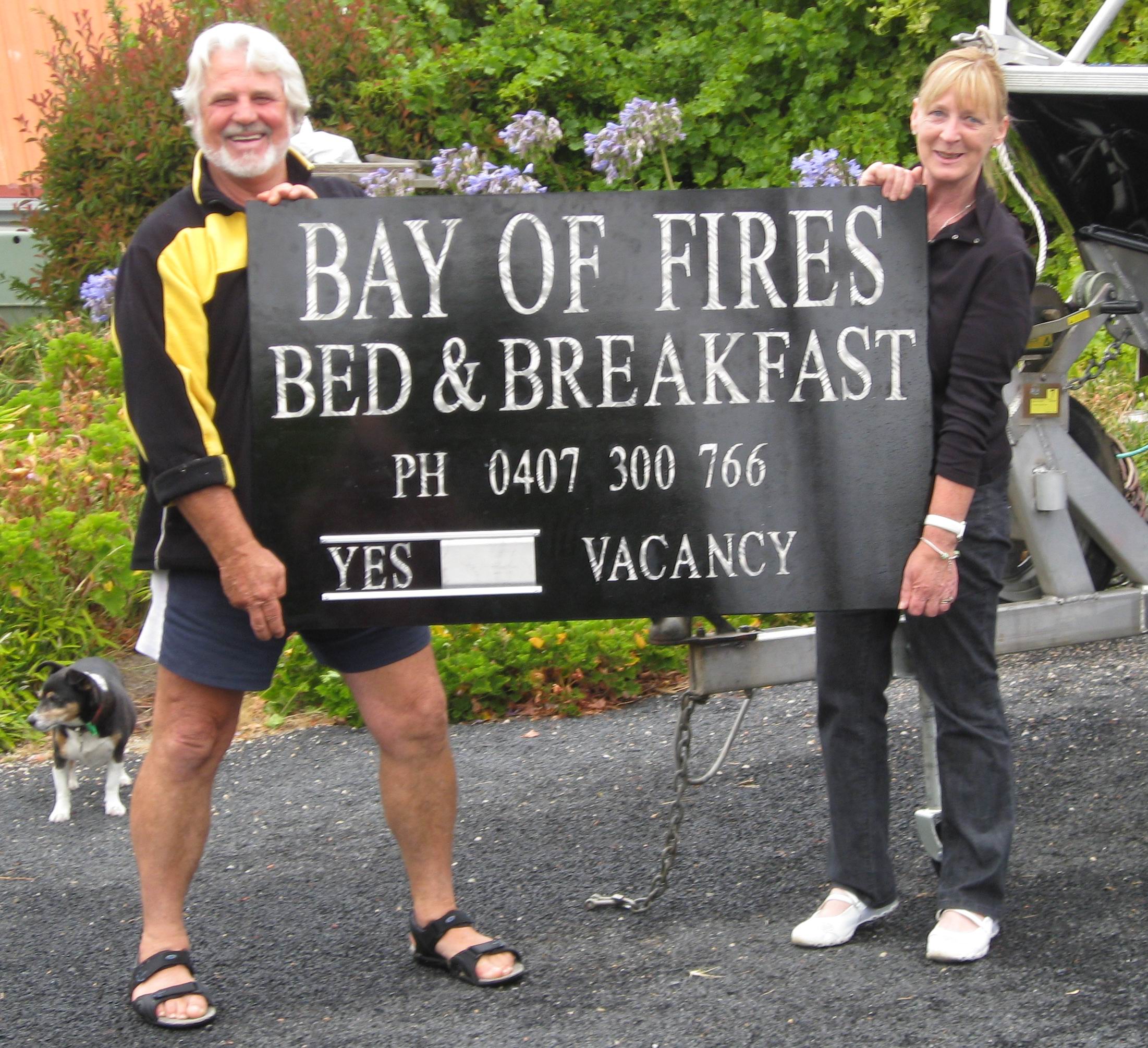
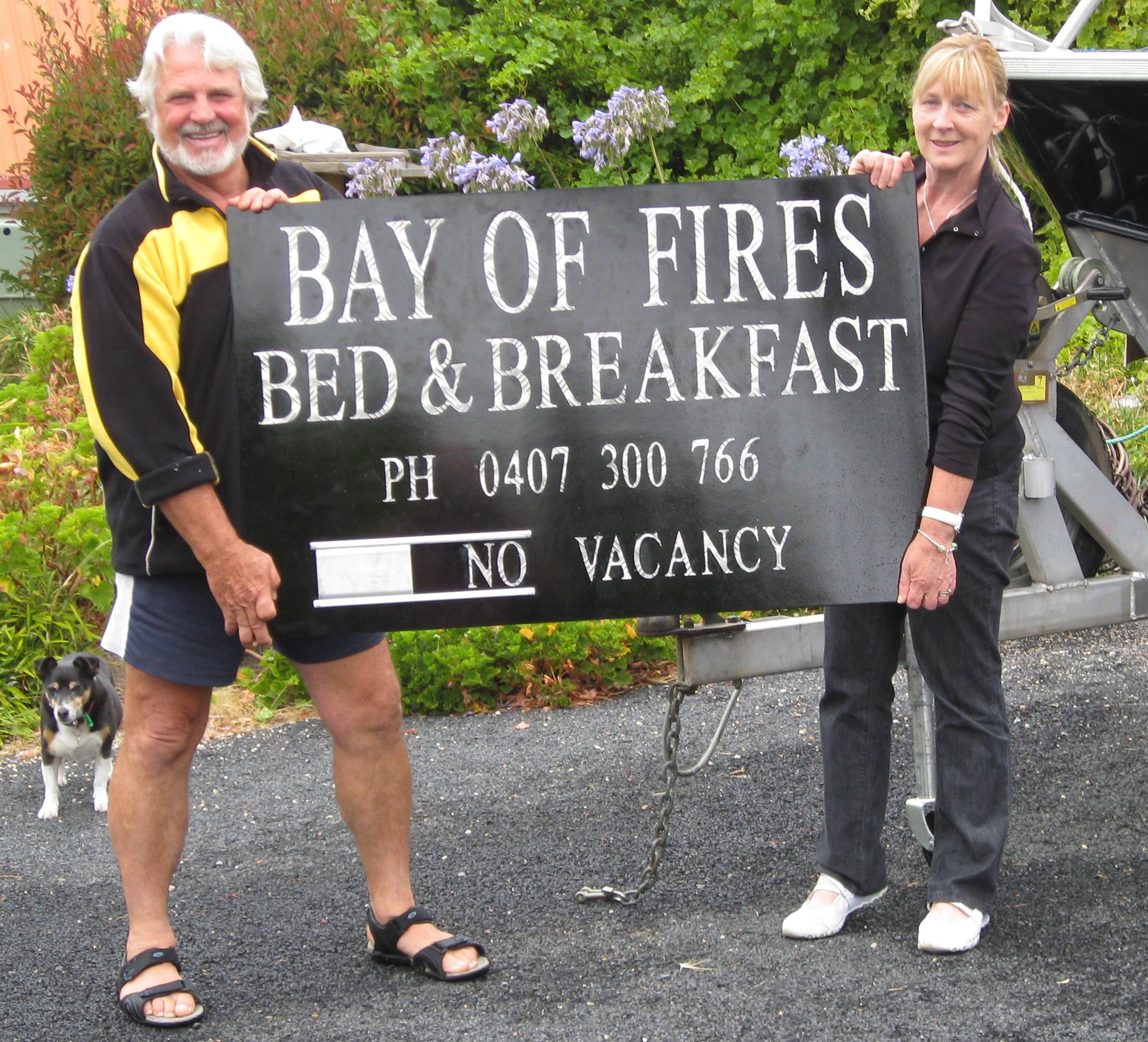
We return to Devonport via the Tasman Highway as far as Scottsdale, and then head north thru Bridport, and Georgetown, and cross the Tamar River at Sidmouth, which cuts off a few Km, but also gives us another interesting look at the northeastern section of Tasmania. We've pretty well driven the other areas of this unique State, and from East to West, North to South, and including the Central Highlands, Tassie is worth exploring!
Speaking of unique, we hear a lot about the poppy farming in Afghanistan, and the impact on illegal heroin and cocaine that has had such a devastating impact on societies across the world, but certainly on the addiction problems of the US. Tasmania, by its physical properties and location, is ideally suited for legal poppy farming, and it does support this crop for many of the world's pharmaceutical companies for the production of legal pain control products.
I really come up short on photos going back, but my excuse is that I was concentrating on all the twists and turns. Lots of winding roads through some beautiful and fertile farm country, and cattle raising areas. I did manage one as we boarded the Spirit II and give some thought to how we'll be spending our last week (bummer!!!) - - - - -
Patty has not had a chance to experience much of Gippsland in her previous travels, or of the coastal drive heading up toward Sydney, and so, in addition to a re-visit to Canberra ( and a catch-up on the changes to the War Memorial Museum there), we decide to introduce her to the beauty of this area.
The trip wouldn't be complete without a swing thru Brett's home town of Korumburra, and the Allen's farming community of Leongatha, on our way to Phillip Island. A slight diversion based on something we've noted a bit more this trip is the closing of some, and conversion of other churches --- this one to a BYO Mexican Restaurant! The crosses are still in evidence, so maybe at some point they'll be recaptured! (Don't you wonder what the Right Rev. G. H. Cranswick would have to say?)
Unfortunately, we encounter the first of a couple of pretty rainy days (wish we could send it north to Peter Miles!), and so the beauty of the Gippsland farming area is a bit obscured. I'd urge you to go to "Australia 2001 - week 6" to get the idea. Rain or no, we continue on to Phillip Island. We're a little early for the penguins, but not for the gist of things, and enjoy the spruce lined streets of the quaint town of Cowes, where we have lunch. The story behind the trees is that they were planted after WWI in memory of those lost in that war.
On to Warragul, where we're invited by the owner of the Great Western Motel where we're staying to have dinner at the Warragul Country Club. Supposedly, they have the best food in town, and it is very good. They also have "pokies" (slot machines) which are very popular in Australia in pubs, and now I learn in the small town "Country Clubs". We're up and at 'em early because we're heading up the coast, eventually to Lakes Entrance, but want to take the opportunity to get out to some of the beach drives (Sea Spray, Ninety Mile Beach, Paradise & Golden Beach, Loch Sport, and Seacombe, etc.) We're still experiencing a little rain, but still an interesting drive.
We arrive in Lakes Entrance, and have a room at the same Best Western I'd stayed at in 2001, although Ron, the owner, has REALLY renovated, and the rooms are terrific! On the way into town we pass Miriam's, an old hotel with a restaurant on the second level overlooking the Esplanade. I seem to recall eating there, and Ron says it's still the best place in town. So back we go, and it is great! I fall in love with Zoe, our waitress who was not there in 2001, or I might never have left Lakes Entrance!! Also not there in 2001 were several impressive chain saw sculptures across the street from Miriam's again honoring those lost in the two World Wars. (You find this kind of dedication and tribute throughout Australia!)
Lakes Entrance is very much a fishing port, and also shows signs of other workboats, but because of the beauty of the lakes areas has become a very popular tourist area as well. That growth in tourism is clear to me versus my previous visit 9 years ago. There must also be growth in the Roo and Wombat populations as well!
We leave for our next stop, Merimbula, but taking a tip from Bill Bachman, we do a slight inland jog, heading north at Cann River on the Monaro Highway (Highway is always a bit of a stretch!), and taking in some of the countryside in the Great Dividing Range area (Bombala, where they "park backwards") before then ducking back to the coast,--- Bega and Tathra.
The drive is a winding, climbing one through many hairpin turns in order to negotiate the sharp ascent, and since it is dreary and rainy, provides little time for picture taking, and avoiding the timber trucks coming down to the coastal ports. Still, even with the weather, the rainforest type atmosphere holds a quiet peace, and tranquility.
as we emerge from the timbered areas, small stations are the
order of business --- and a large flock of Cockatoos make their presence known!
We're now heading back to the coast, and to Bega and the small coastal town of Tathra, before wrapping up our day in Merimbula. Tathra was one of my favorite stops in 2001, and while the normal activity there is whale watching -- today it appears to be a wedding that brings out the Tathrans! (Also, check out the unique combination cleaning business!)
--and then Merimbula, another beautiful coastal community!
We enjoy a great meal at a terrific seafood restaurant,
Wheeler's Oyster Farm & Seafood Restaurant in Pambula (just across the bay from
Merimbula). The next day we head up the coast, and immediately come
across a great surfing area, where the surfers are already up and at 'em to
catch the waves!

We leave the surfers behind us, but see all
kinds of others out, enjoying their Sunday ---
--- and then, one of my favorite roadside
guidance signs --- probably not bad advice for a one lane bridge!
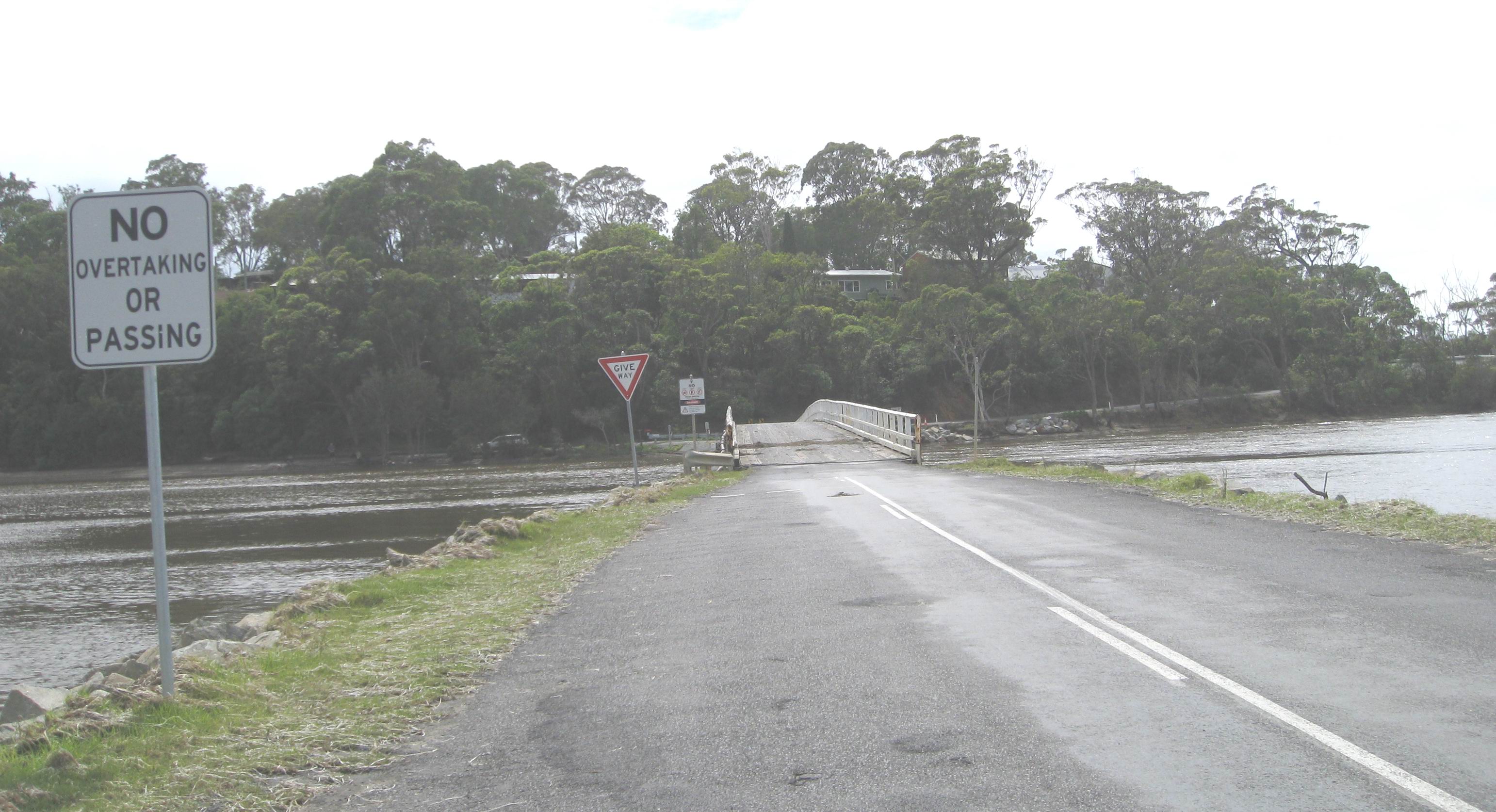
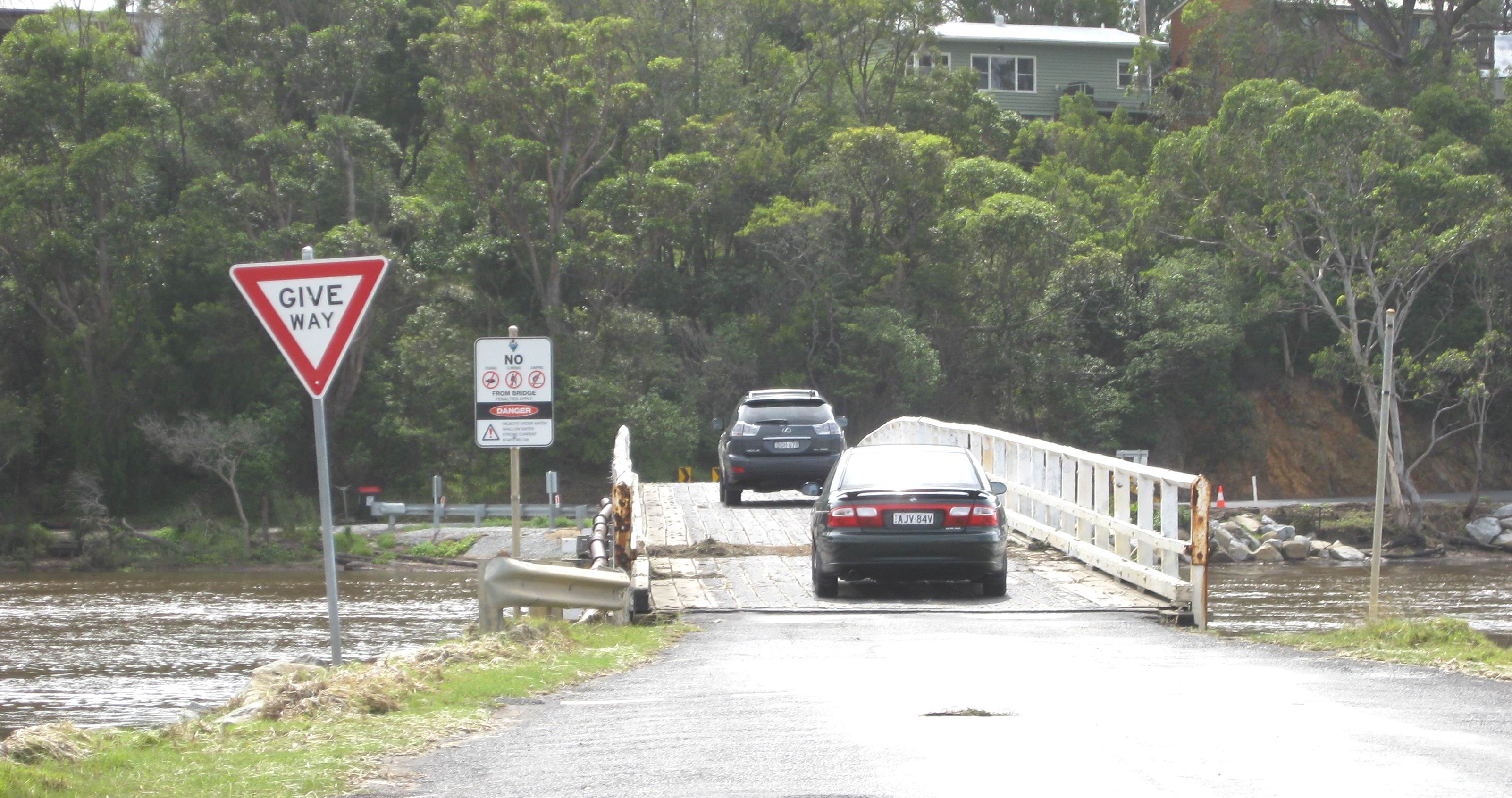
We continue up the coast to Batemans Bay, and then once again head inland -- this time headed for Canberra.
It seems like a good time to give you a thought or two about
Canberra. Patty and I were last in Canberra in 1999. At
that time, we came away so impressed with this unique capital city in general,
but in particular with the National Australian War Memorial Museum.
When we had dinner with Lew Fisher in Melbourne (see Week 3)), he mentioned that
they had significantly expanded and improved the War Memorial Museum.
I had written in my journal following our 1999 visit (this was before I'd
started a website) that the War Memorial Museum in Canberra was the finest
museum of its type that I'd ever experienced, including Europe and the US.
For that reason alone, I decided then that we'd adjust the tail end of our
visit, and I'm glad we did!
However, since I've not commented on Canberra before on this website, it seems a little perspective on this unique city is in order. Canberra, along with the area designated as The Australian Capital Territory is located within New South Wales. It is located some 300 Km (185 miles) southwest of Sydney, and is Australia's political heartland. The city was actually planned in 1908 as the new seat of federal parliament to end the rivalry between Melbourne and Sydney. The surrounding Australian Capital Territory features bush and mountain terrain. (It is also occasionally described as a rural city, ringed by gum trees, with the occasional kangaroo seen hopping down its suburban streets.)
What was interesting to me, when we first visited Canberra, was to learn that Canberra was once little more than a sheep station on the edge of the Molonglo River, and that American architect Walter Burley Griffin won an international competition to design the city. He envisioned a spacious, low-cast, modern city, with its major buildings centered around the focal point of Lake Burley Griffin. Canberra (its name is based on the Aboriginal word meaning "meeting place") is a bit a city of contradictions. It consists of more than just politics, diplomacy and monuments. Lacking the traffic and skyscrapers of Australia's other main cities, it has a serenity and country charm suited to strolling around the lake, bush driving, and picnicking!! Still, Canberra holds most of the nation's political, literary, and artistic treasures, and contains important national institutions such as the High Court of Australia, the Australian National University, and the Australian War Memorial, but still has a population of slightly over 500,000.
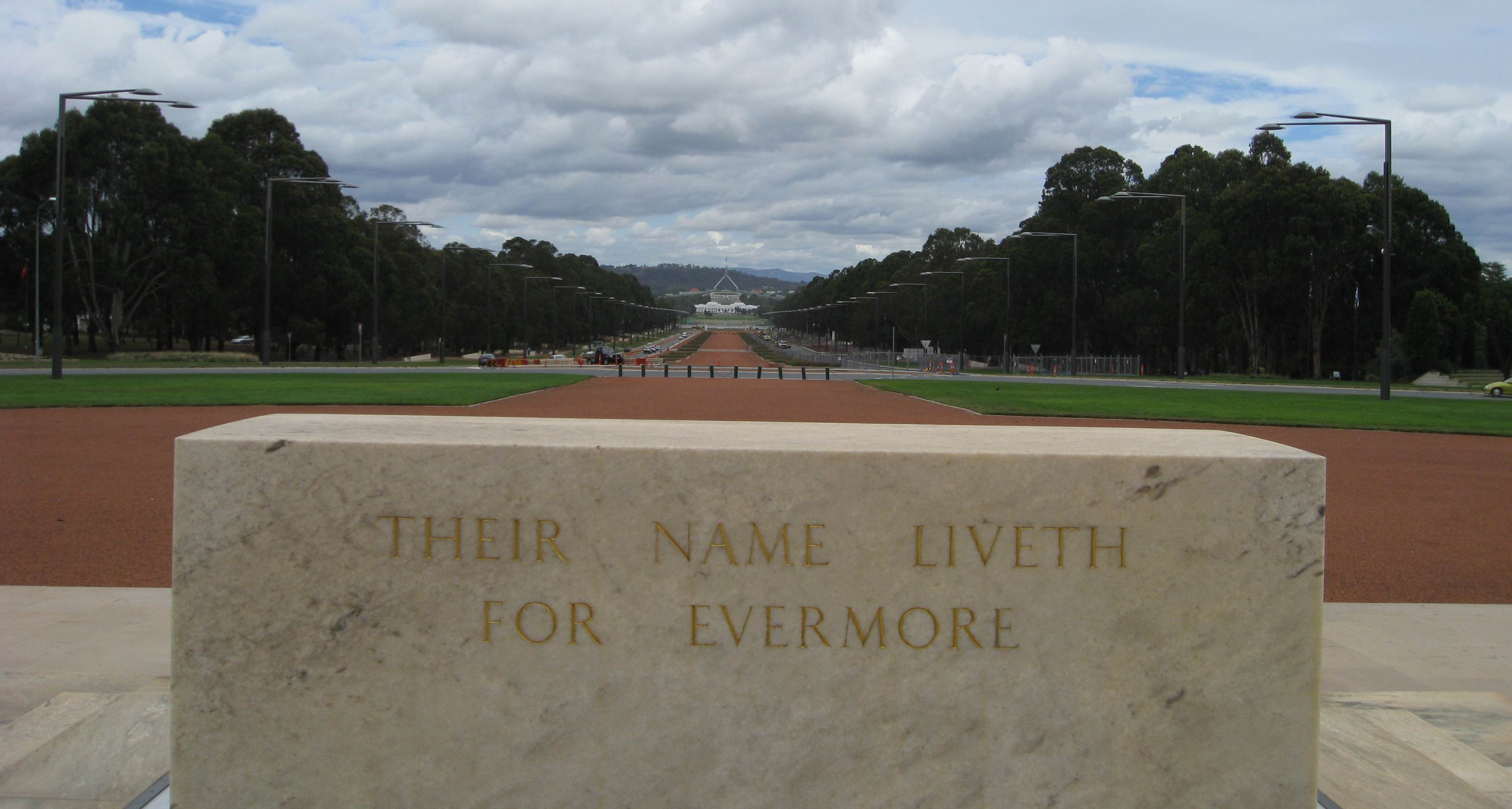
Above, a view from the War Memorial Museum down ANZAC Way to Parliament.
Below, the view of the War Memorial Museum .
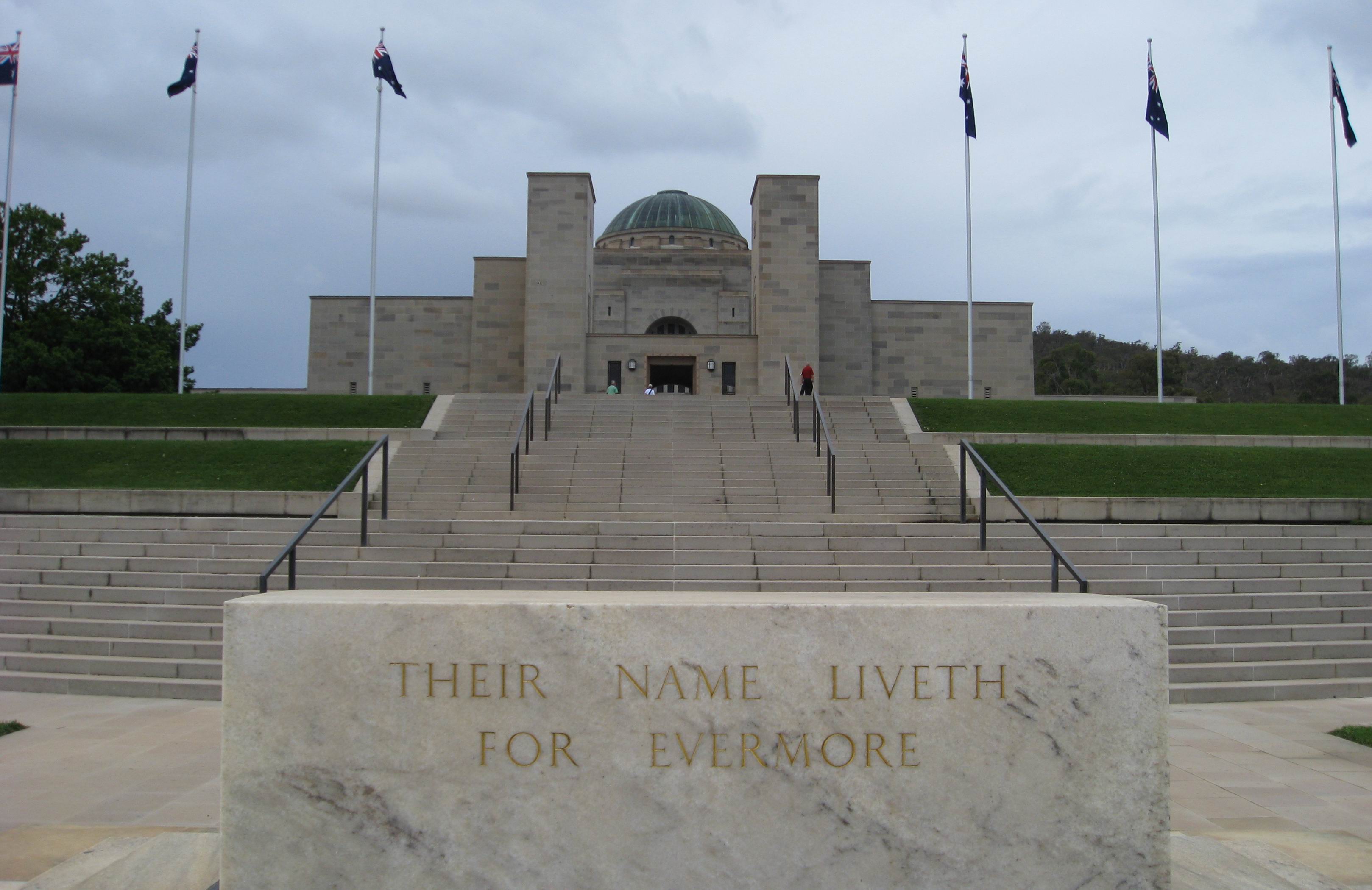
The grounds are just very tastefully done and manicured, with plaques everywhere honoring various units from all of the many campaigns in which the Anzac forces, and in more recent conflicts, the Australian forces, have participated. (At 137 kilos, I give some perspective to the beautiful and mature gums trees surrounding the Museum buildings!)
One of the things that has always captured my attention (as you've undoubtedly noticed if you've looked through "Australia 2001" and "Australia 2004") as I've traveled every nook and cranny of this great country, is the obvious focus on memorials to the two great wars, --- no matter the size of the towns, from small bush communities to the largest cities. It is a fact that when it came time to serve, Aussies have always led with a higher percentage of their eligible young men serving than any other country. Unfortunately, some have contended that due to some questionable British strategies, Aussies also led in a sadder category, -- the percentage of their troops that paid the ultimate price. While the museum addresses both these facts, it does so in a positive and prideful way.
On the two occasions that Patty and I have spent hours at this museum, we've noted the same thing that we see in our own museums in the US -- a large number of men and women, obviously veterans of one or more of these conflicts, sharing stories and memories. I hope this is not unfair, but on both occasions, we also noted something that we've not experienced to the same degree in the US --- and that is the number of young (16 - 35) men and women who were spending more than just a passing moment living history through the exhibits at The War Memorial Museum. I did not query any this trip, but back in 1999, I did speak to two young men who were separately spending a few days at the museum. What struck me then, and stays with me today, is that in both cases these young men were not doing this to capture material for a school assignment, but were just moved by what they had learned in school history classes, or discussions at home with family, and wanted to better understand the details of the battles, and the men and women who sacrificed for their country, as well as the reasons why these conflicts developed in the first place.
Several things stand out to us about this magnificent museum. First, since both New Zealand and Australia are relatively young countries, WWI & WWII are a huge part of their history. Grade school children in Australia know more about those wars than that same age group in the US. (It is also why Australian children, particularly in the Northern Territory, hold Yanks in awe and respect because of our ability to have repelled the Japanese during WWII.) Second, there is just no way to capture the power of the impressions that the exhibits give to the visitor. A few pictures follow, but for the most part I found myself feeling as though a flashing camera was not the way to experience this setting, and with the exception of a couple of planes, and other pieces of equipment, many if not most of the exhibits really created its own atmosphere that was very thought provoking and moving, and snapping pictures was far from your prevailing thoughts!
The newest areas bring Viet Nam and other areas (East Timor, etc) in to the Memorial Museums displays, and as with the rest of the Museum is very well done. Those of us who were frustrated by much of the Viet Nam press coverage in this country will identify with the following reaction by an Australian officer to the press in Australia during this same period of conflict --
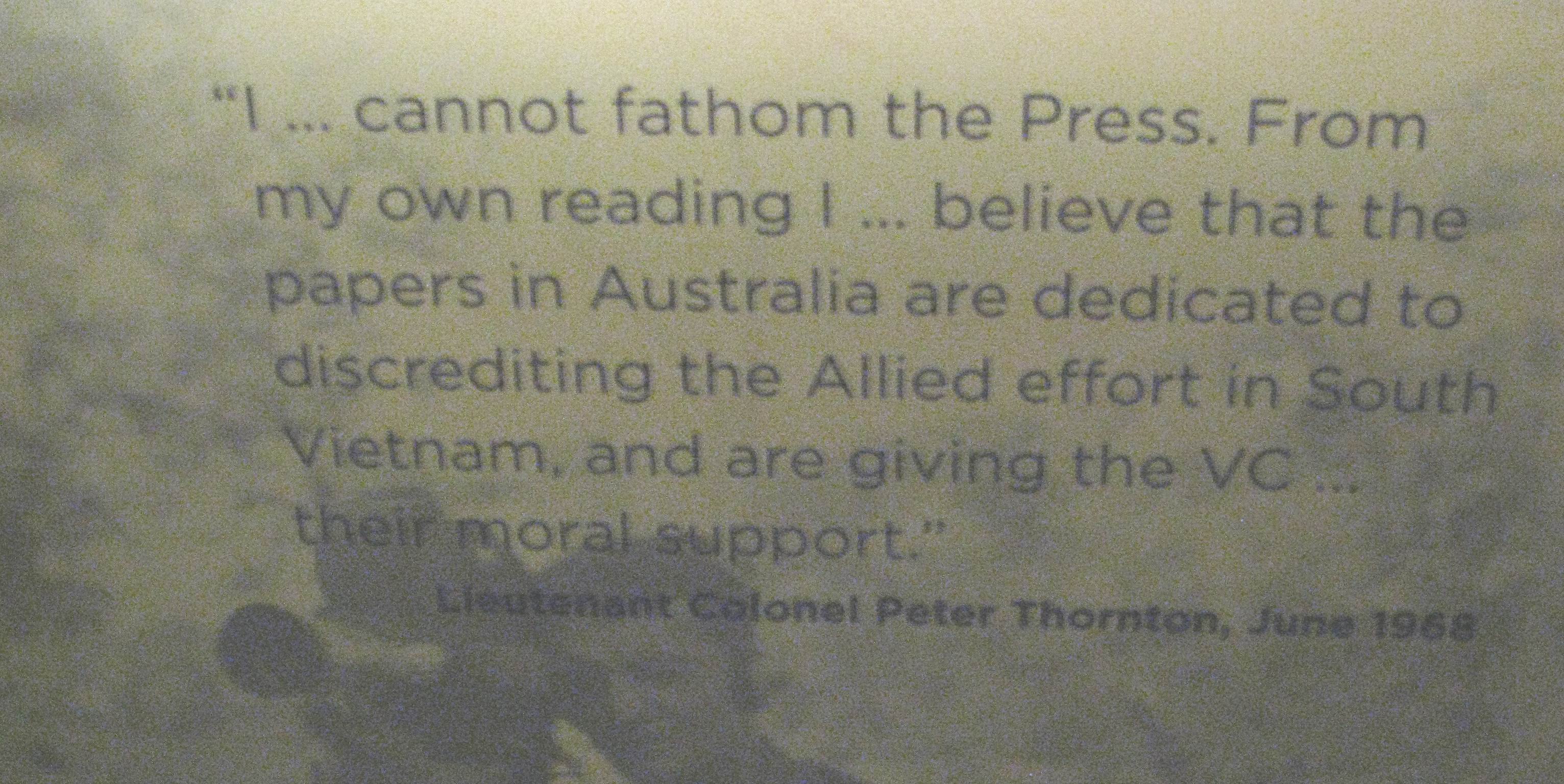
The other rather unique characteristic of Canberra is the Embassy buildings that make up their Embassy Row. One can pretty much identify the Embassies before seeing signage because of the architecture. See if you can get them right! (Answers below.)
Row 1 - Greece, Japan, Thailand, U.S., U.S. being chased off for taking picture. No shots fired!
Row 2 - S. Africa, France, Indonesia, Egypt, Finland & Singapore Row 3 - New Guinea, New Zealand, China
We leave Canberra in the rear view mirror as we're wrapping up our visit to Australia. this time. We'll spend our last day driving along the coast, visiting some of the beautiful small communities between Bateman's Bay and Wollongong, where we'll spend our last night, before flying out of Sydney. I've just strung a few pictures taken on that last day of driving (on the left side of the road!), starting with the steep downhill run from Canberra to the coast, stops at Ulladulla, Mollymook, Nowra, and on to Wollongong.
Lots of memories from these shots and others that preceded them. Seeing how the Aussies live, trying to create an understanding for those who may never have visited this great country, yet, just what spectacular people the Aussies are. Australia is a beautiful country, diverse in its beauty, but what always sets it apart from the other areas where Patty and I have been privileged to visit is the people. I always leave here as - - - - -
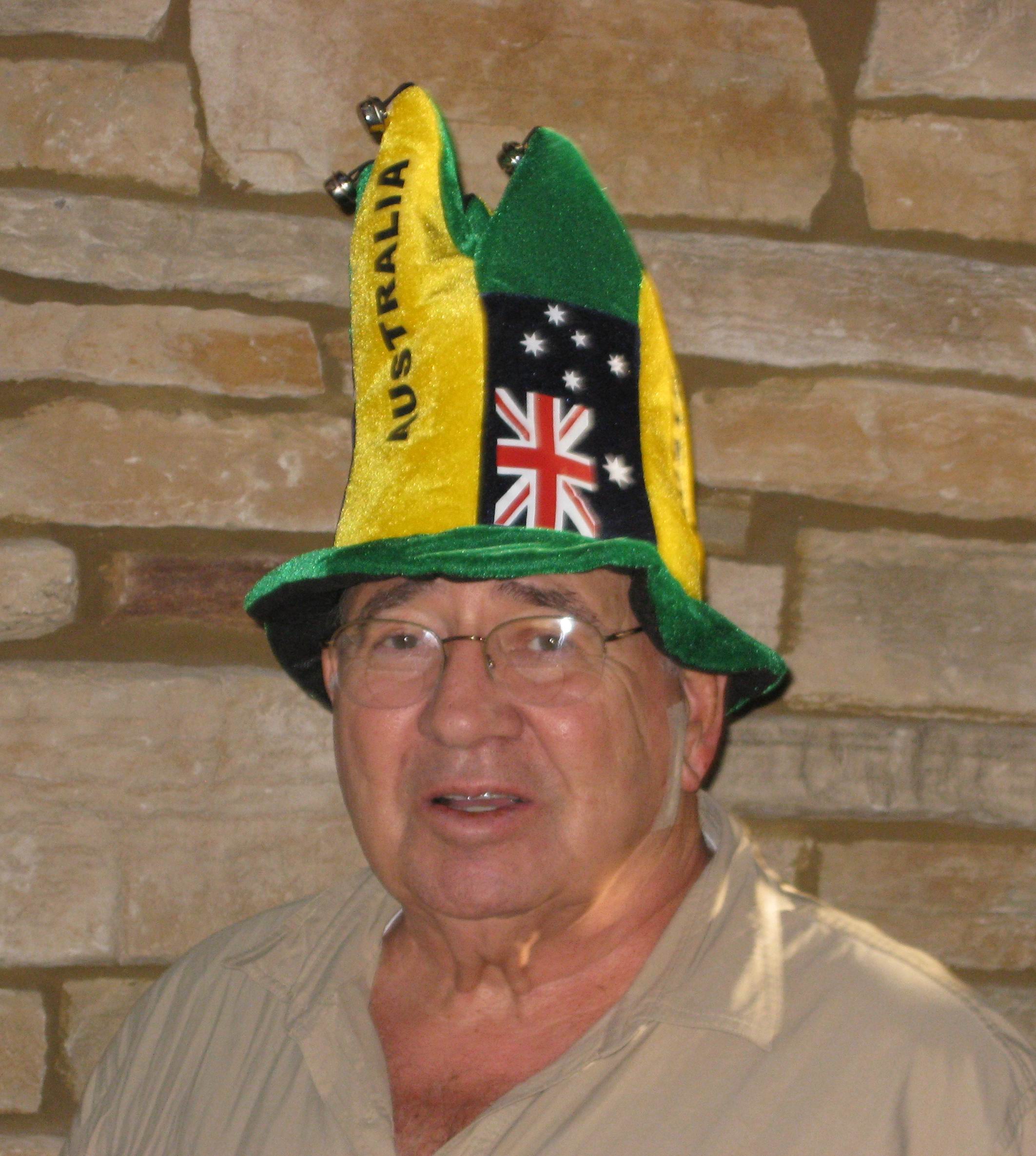
One Happy Bloke!
















